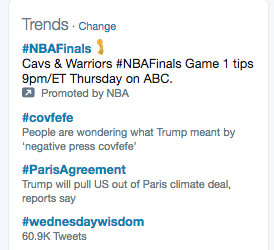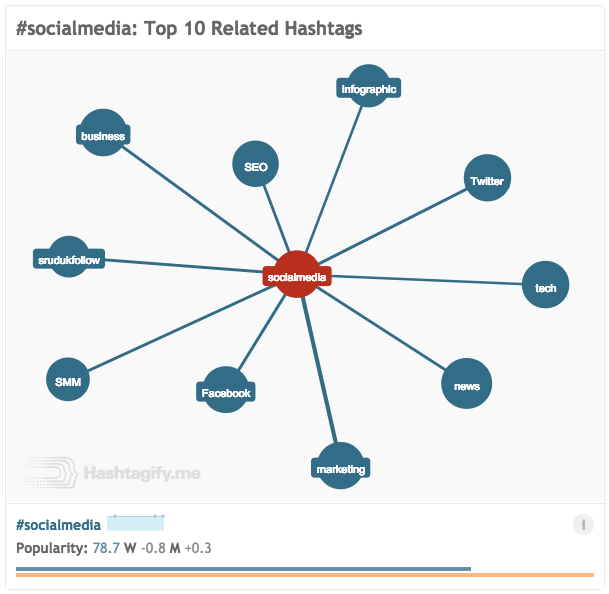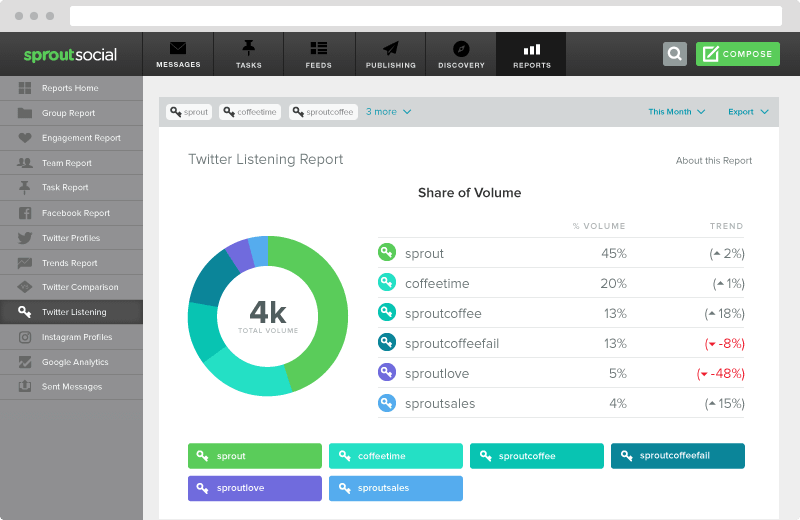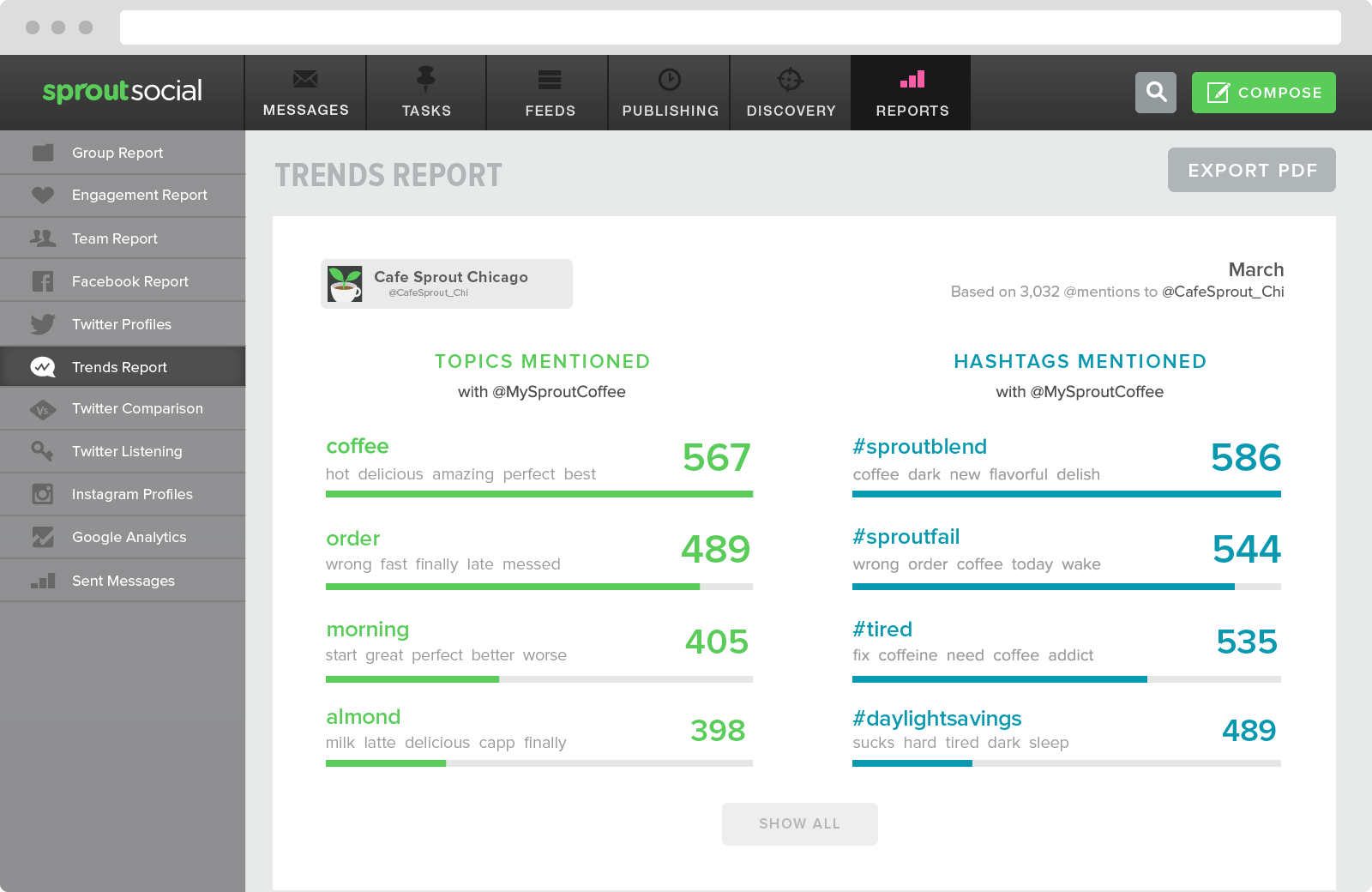Including trending and popular Twitter hashtags in your social media posts is a great way to boost your messages to reach people beyond just your own followers. When you use a popular hashtag in a post, you expose that message to everyone discussing that topic and looking at the messages relevant to that subject.
However, in order to take full advantage of this, you’ll need to know which hashtags will work best for you using our Twitter Analytics and more tools on this list.
Sign up for a free 30-day trial with Sprout Social to start tracking all your hashtag data!
Sprout Features Mentioned in This Article
9 Tools to Find the Best Twitter Hashtags
For quite some time, this topic has been one of the most widely discussed on the Sprout Social Insights’s blog, so we thought it was due to really build it out to help our readers. We’ve put together a list of nine hashtag tools, broken down by category, that will help you increase your social reach and brand awareness.
If you’re completely new to the concept of hashtags, you can check out our complete guide:
Great marketers have found success in the use of real-time marketing, which is the idea that you include something topical—something that’s trending—in your social media posts to help increase the overall reach.
In order to capture the most reach, you’ll need to figure out what is trending at the time and create relevant content for that hashtag. These tools can help you find trending hashtags and give you a description so that you can create fitting content.
1. Twitter Native
The most obvious place to check out trending hashtags is the actual Twitter website because it has the most accurate information on the subject. Not only is this the best source based on legitimacy of data, but Twitter also offers “tailored trends” to each user based on where they are and who they follow.

The only negative to Twitter’s hashtags is that it is only gives you a snapshot of the top trending topics. If you’re looking for more hashtags, you’ll need to use a third-party application.
One handy trick to squeeze a few more trending hashtags is to use the mobile app instead of the desktop. Go into the search tab and Twitter will display the top trending topics personalized to your account. If you scroll to the bottom of the “trending now” section, tap on more.

This will show you a list of the top 20 trending topics.
2. Trendsmap
Trendsmap is a navigational tool that allows you to look up the trending hashtags by location. This is fun and powerful for marketers because you can see how different locations are discussing different events online, and use that information to geo-target your messaging.

Getting a pulse on what’s going around in your local area is a great way to speak directly to segments of your audience. The trending topics in Chicago can look completely different from what’s trending in San Francisco or New Mexico. Whether your brand is national or local, this is a handy hashtag finder to go beyond the more broad national trending hashtags.
If you want to get really creative, find which hashtags are trending in a specific geographic location. Then you run ads against people in those areas and include the top hashtags in your Tweet.
3. Sprout Social
Full disclosure, Sprout Social is the company that brought you this article, but we really do have a fantastic tool for hashtag research. When you’re researching hashtags to use, it can be beneficial to see which hashtags are already associated with your brand. Sprout Social’s Trends Report analyzes all of your incoming messages and shows which hashtags are trending with your personal brand.
Once you know which topics and hashtags are being associated with your brand, you can start to use those terms to jump into the conversations with your followers.
4. RiteTag
RiteTag is an amazing tool for a handful of reasons. The first is that it provides a list of trending hashtags on its site that you can use to take advantage of real-time marketing.

RiteTag will also give you feedback on your hashtags as you type, which indicates the strength of your Twitter hashtag.
Leveraging trending hashtags for increased reach is a great idea, but what’s trending isn’t always what’s most relevant for your brand. However, it’s still a good idea to pepper your posts with hashtags to incrementally increase impressions. Try using hashtags that used to be popular. One example would be the NFL taking part in the “throwback Thursday” discussion.
5. #tagdef
Tagdef—as in hashtag definition—is a site that lists popular hashtags by time frame, including current, weekly and all-time top hashtags. Tagdef is also great since the site provides the definition for each hashtag, making it easier for marketers to familiarize themselves with the topic before diving in to create the content.

Use Tagdef to avoid looking like the out of touch brand jumping on trending topics without actually knowing what they mean. It’ll save you a lot of embarrassment and awkwardness.
6. hashtagify.me
Hashtagify.me is a hashtag finder that makes it easy to search for hashtags related to those you want to target. You can then use those hashtags along with your original to increase your reach by that much, leading to more clicks and conversion on your posts.

When you’re creating and managing hashtag campaigns, it can be incredibly valuable to visualize all of the engagement taking place. These tools will help you anticipate campaigns, making it easy to monitor all the activity surrounding your hashtag.
7. Tint
Once you’ve started your hashtag campaign, you can use Tint to aggregate all of the social posts containing that hashtag into a beautifully designed social hub.

The above is an example of the Nasdaq team displaying its social feeds using Tint.
8. Tagboard
Tagboard is one of the most aesthetically pleasing of all of the hashtag research sites. For each “Tagboard” you create, you specify a hashtag for it to track. Tagboard then displays popular posts containing that hashtag on a board that looks similar to the one below.

You can then easily peruse all of the posts that contain your specific hashtag. The tool has also incorporated “Feature Post,” which pulls that post to a separate board, making responding easy.
9. Keyhole.co
Keyhole originally created its platform for internal use, but decided to open it up to the public when it started receiving some positive feedback. Keyhole has features that are available for free, but more advanced features are accessible only for paid membership.

The above is an example of a fantastic word cloud that Keyhole generated when we searched for the hashtag #socialmedia. Each of those hashtags associated with #socialmedia are also clickable, which makes it easy to search Twitter hashtags around a specific theme.
Creating Your Own Twitter Hashtag
The tools above are all great for finding existing popular and trending hashtags, but what if you want to create a hashtag of your own?
Branded hashtags can bring your community together, differentiate you from the competition and add a little fun into your Twitter marketing strategy.
Not all branded hashtags are created equally though. Great hashtags are easy to remember, readable and unique. This is a hashtag that’s going to be associated with your brand, so you should put some thought into it. Here are some tips to make sure you get the most from your branded Twitter hashtag.
Attach Hashtags to a Campaign
Most branded hashtags will fall under one of two categories:
- Always-on hashtags
- Campaign specific hashtags
Always-on hashtags are ones like Nike’s #Justdoit or Under Armour’s #IWILL. They’re a part of your brands overall messaging and not specific to any singular campaign. You’ll often see these types of hashtags used when followers share user generated content for their favorite brands.
The second is campaign specific hashtags. These typically have a shorter lifespan and are used for a particular promotion. For instance, for National Alzheimer’s Awareness Month, the Alzheimer’s Association promoted the hashtag #EndAlzheimers.
The advantage of these hashtags is that they can be tied back to a specific campaign. Whenever you’re running a contest, competition or campaign, create a branded hashtag to go along with it. Then you can use a tool like Sprout with hashtag tracking to get an in-depth look at your campaign’s performance.

Perform a Hashtag Search First
Before you settle on a hashtag, make sure you search Twitter for it. Specifically, you want to make sure nobody else is using the same hashtag and that it’s not tied to anything negative or outside your brand. If your desired hashtag was used several years ago, it’s probably safe to use it. But if a well-known brand is using it as a part of a current campaign, it’ll create a lot of confusion and make your legal team cringe.
Don’t Make the Hashtag Too Long
We’ve all done it before. Whether it’s typing out a text or Tweet, missing a character or misspelling a word happens all the time. The longer your Twitter hashtag is, the more likely it’ll be that someone will make a typo when trying to Tweet it.
You want your hashtag to be something that people can easily remember and spell. Some things to look out for are:
- Using multiple words that end and start with the same letter (#gamingguys). These doubling up of letters looks confusing and makes it a little difficult to quickly write out.
- Making it over three words long (#itsgamedaytoday). Your hashtags shouldn’t turn into complete sentences. Ideally, keep your hashtags to fewer than three words.
- Using words that run into each other. The classic example of this mistake is is Susan Boyle’s album release party hashtag fail. When you’re stringing together multiple words in a single hashtag, double check for any hidden messages.
Avoid Using Too Many Hashtags in a Tweet
This tip goes for both branded and non-branded Twitter hashtags. Unlike Instagram where it’s pretty common to see 10+ hashtags in a single caption, Twitter is a little less welcoming to hashtag cramming.
Keep your number of hashtags in a Tweet to less than three. But one will usually be enough, particularly if it’s a branded hashtag that’s a part of a campaign.
In Closing
Hashtags are an extremely popular aspect of Twitter and other social media sites, and should be utilized by brands to assist in their marketing. That’s why it’s important to make sure that you’re using the best tools to research, create and monitor all of the hashtags associated with your brand.

If you’re looking for a good place to start, try out Sprout Social’s Twitter Keyword Report to see which hashtags and keywords people are currently discussing around your brand.
